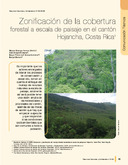| dc.contributor.author | Serrano Dávila, M.E. | |
| dc.contributor.author | Campos Arce, José Joaquín | |
| dc.contributor.author | Villalobos Soto, Róger | |
| dc.contributor.author | Galloway, Glenn | |
| dc.contributor.author | Herrera, Bernal | |
| dc.date.accessioned | 2015-03-19T22:16:38Z | |
| dc.date.available | 2015-03-19T22:16:38Z | |
| dc.date.issued | 2007-08 | |
| dc.identifier.issn | e-ISSN: 1659-1216 | es_EN |
| dc.identifier.uri | https://repositorio.catie.ac.cr/handle/11554/6931 | |
| dc.identifier.uri | 471967 | es_ES |
| dc.description | 11 páginas, 5 ilustraciones, 7 tabulaciones, 13 referencias. | es_ES |
| dc.description.abstract | Este estudio desarrolla una propuesta de ordenamiento de los ecosistemas forestales en el cantón de Hojancha, Costa Rica, en función de tres elementos claves: conocimientos de la población local, producción forestal y uso del suelo. El objetivo general de investigación fue contribuir a la planificación integral de la producción forestal sostenible y de la conservación ambiental a escala de paisaje en el cantón. La metodología utilizada descansa en tres ejes: el sistema de información geográfica, las perspectivas locales y el software de manejo forestal SILVIA, el cual se centra en el ordenamiento de la producción forestal. Los resultados del estudio demuestran que aproximadamente un 70% del área del cantón se encuentra bajo un uso adecuado del suelo, y que se han dado avances significativos en la recuperación de la cobertura forestal y la restauración del paisaje. | es_ES |
| dc.description.abstract | The management of forest ecosystems is the arrangement of the human use of forest resources and of the interactions between humans and these ecosystems. The study’s main objective was to contribute to an integrated planning for sustainable forest production and environmental conservation at the landscape scale in Hojancha. The methodology was founded on three basic tools: the geographic information system, the local perspectives, and the forest management software SILVIA for forest production management. The research results showed that approximately 70% of the county’s area is under appropriate land use, and forest cover restoration has reached important advances. | |
| dc.format.mimetype | pdf | |
| dc.language.iso | es | es_ES |
| dc.publisher | CATIE, Turrialba (Costa Rica) | es_ES |
| dc.publisher | CATIE, Turrialba (Costa Rica) | |
| dc.relation.ispartof | Recursos Naturales y Ambiente Número 51-52 (Agosto-Diciembre 2007), páginas 85-95 | |
| dc.rights.uri | https://creativecommons.org/licenses/by-nc-nd/4.0/ | |
| dc.subject | COSTA RICA | es_ES |
| dc.subject | ECOSISTEMA | es_ES |
| dc.subject | RECURSOS FORESTALES | es_ES |
| dc.subject | ORDENACION FORESTAL | es_ES |
| dc.subject | CUBIERTA VEGETAL | es_ES |
| dc.subject | PAISAJE | es_ES |
| dc.subject | CONSERVACION DEL PAISAJE | es_ES |
| dc.subject | ORDENACION TERRITORIAL | es_ES |
| dc.subject | UTILIZACION DE LA TIERRA | es_ES |
| dc.subject | ZONIFICACION | es_ES |
| dc.subject | SISTEMAS DE INFORMACION GEOGRAFICA | es_ES |
| dc.title | Zonificación de la cobertura forestal a escala de paisaje en el cantón Hojancha, Costa Rica | es_ES |
| dc.title.alternative | Determination of landscape forest cover in Hojancha, Costa Rica | es_ES |
| dc.type | Artículo | es_ES |
| dc.journal.issueNumber | 51-52 | |
| dc.journal.pages | 85-95 | |



